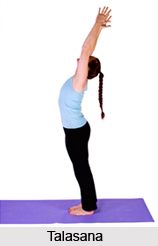 Talasana is a cultural yoga asana that translates to the palm tree pose, and is an upward stretching posture that is essentially the Yastikasana performed while standing. It exercises the spinal muscles, especially the flexors and the extensors, and the hip abductor. It has three variations, which vary only in the position of the outstretched arms in the final posture.
Talasana is a cultural yoga asana that translates to the palm tree pose, and is an upward stretching posture that is essentially the Yastikasana performed while standing. It exercises the spinal muscles, especially the flexors and the extensors, and the hip abductor. It has three variations, which vary only in the position of the outstretched arms in the final posture.
Meaning of Talasana
Talasana translates to the palm tree pose in Sanskrit, and derives its name from the fully stretched posture resemblance to a tall, curving palm tree.
Practice of Talasana
A sequential process for performing Talasana and its variations follows.
* Stand properly, keeping the feet parallel. According to convenience, keep them together or slightly apart from each other.
* Place the hands at their respective sides, throw the chest forward, keep the lneck straight and the abdomen in a normal contour, with the chin drawn in.
* As you start to raise one arm, inhale slowly so as to take in a full breath before the arm reaches the vertical position, while simultaneously raising the toes.
* With the arm fully stretched, take a deep breath, till you feel close to bursting. Rise fully on your toes, and retaining breath, stretch your body upward to the maximum height, maintaining this pose for 4 seconds.
* One variant of this asana involves using both arms instead of just one arm.
* A second variant involves stretching the arms slightly sidward, instead of upward.
* In the third variant, the arms are stretched so far sideward (above the head) as to cross each other.
Effects of Talasana
The palm tree pose and its variants essentially stretch the thorax, the lower abdomen through the alternate and regular movements of skeletal and muscular upward movements. Along with regular breathing, they offer the best all round expansion of the lungs. The upraised arms offer maximum space for deep breathing, and while exhaling, the diaphragm, pressed upwards, makes exhalation natural and easy. The asana strongly exercises the respiratory muscles and expands the chest, bringing in all the extensors of the back and the shoulder muscles. It exercises the flexors also, and conditions the muscles of the ankle due to the tiptoe posture
Precautions in the practice of Talasana
Like other upward stretching exercises, it is vital to make sure that one breathes deeply during stretching and exhales during relaxing the body, to maintain the natural flow of one`s breath and movements. One should not attempt the posture abruptly and maintain the correct standing posture before performing the asana.
Talasana is a fitting exercise for respiratory ailments since it involves significant deep breathing, facilitated by the natural stretching of the body. The intense stretch also implies especial care must be taken to maintain the proper rhythm of breathing.




















